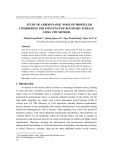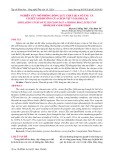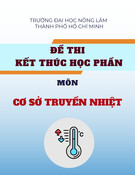
REGULAR ARTICLE
CADOR “Core with Adding DOppleR effect”concept application
to sodium fast reactors
Alain Zaetta
1,*
, Bruno Fontaine
1
, Pierre Sciora
1
, Romain Lavastre
1
, Robert Jacqmin
1
, Vincent Pascal
1
,
Michel Pelletier
1
, Gérard Mignot
1
, and Aurélien Jankowiak
2
1
CEA Nuclear Energy Division, Cadarache Center, 13108 Saint-Paul-lès-Durance, France
2
CEA Nuclear Energy Division, Saclay Center, 91191 Gif sur Yvette, France
Received: 5 October 2017 / Received in final form: 9 October 2017 / Accepted: 30 November 2018
Abstract. Generation-IV sodium fast reactors (SFR) will only become acceptable and accepted if they can
safely prevent or accommodate reactivity insertion accidents that could lead to the release of large quantities of
mechanical energy, in excess of the reactor containment’s capacity. The CADOR approach based on reinforced
Doppler reactivity feedback is shown to be an attractive means of effectively preventing such reactivity insertion
accidents. The accrued Doppler feedback is achieved by combining two effects: (i) introducing a neutron
moderator material in the core so as to soften the neutron spectrum; and (ii) lowering the fuel temperature in
nominal conditions so as to increase the margin to fuel melting. This study shows that, by applying this CADOR
approach to a Generation-IV oxide-fuelled SFR, the resulting core can be made inherently resistant to reactivity
insertion accidents, while also having increased resistance to loss-of-coolant accidents. These preliminary results
have to be confirmed and completed to meet multiple safety objectives. In particular, some margin gains have to
be found to guarantee against the risk of sodium boiling during unprotected loss of supply power accidents. The
main drawback of the CADOR concept is a drastically reduced core power density compared to conventional
designs. This has a large impact on core size and other parameters.
1 Introduction
The sustainable development of nuclear energy depends on
its capability to make a rational use of natural resources,
minimise its waste production, be economically competi-
tive and, above all, guarantee a safety level that is
considered acceptable by the general public.
Therefore, the fundamental nuclear safety objective
assigned to fourth-generation reactors is to eliminate the risk
of radioactive releases, which would require extremely
restrictive offsite measures even in the case of a severe
accident. For this reason, the Western European Nuclear
Regulators Association (WENRA) states in its report [1]
that “accidents with core melt which would lead to early or
large radioactive releases have to be practically eliminated
and, for those that have not been practically eliminated,
design provisions have to be taken so that only limited
protective measures in area and time are needed for the
public and that sufficient time is available to implement
these measures”. Reaching these objectives means guaran-
teeing that under no circumstances can there be a release of
mechanical energy higher than the reactor’s containment
capacity.
With this in mind, the fourth-generation reactors have to
be designed in line with two key aspects: prevention and
mitigation of severe accidents. Prevention involves the
implementation of all possible technical means to avoid such
severe accidents. As part of the fourth level of defence in
depth, mitigation involves the implementation of suitable
devices designed to manage core meltdown situations and
their consequences.
Core meltdown accidents that result in the release of
unacceptable quantities of energy are caused by prompt
critical reactivity excursions. In prompt critical conditions,
the dynamics of the transient is governed by the time between
two successive generations of prompt fission neutrons, which
is extremely short, i.e. some microseconds. The resulting
rapid power increase can then lead to a violent release of
mechanical energy and the destruction of the reactor, as was
the case during the Chernobyl accident in 1986 [2].
In the case of sodium-cooled fast reactors (SFR), rapid
reactivity insertions can be triggered by different initiators
depending on the reactor design and operating conditions.
The main reactivity insertion accident initiators are as
follows:
–flow of a large gas bubble through the core;
–significant core compaction
–sudden break of the core support structure, leading to the
withdrawal of all the control and safety rods from the core.
*e-mail: alain.zaetta@cea.fr
EPJ Nuclear Sci. Technol. 5, 1 (2019)
©A. Zaetta et al., published by EDP Sciences, 2019
https://doi.org/10.1051/epjn/2018049
Nuclear
Sciences
& Technologies
Available online at:
https://www.epj-n.org
This is an Open Access article distributed under the terms of the Creative Commons Attribution License (http://creativecommons.org/licenses/by/4.0),
which permits unrestricted use, distribution, and reproduction in any medium, provided the original work is properly cited.

The time needed to detect the problem and trigger the
automatic shutdown system by gravity drop of the safety
rods is too long, for this type of sequences, to be effective,
i.e. about 1 s, compared with a tenth of a second for the
duration of this type of accident. As the conventional
protective system cannot provide protection, these con-
ditions must be eliminated.
The “practically eliminated”approach involves demon-
strating that the implementation of a sufficient number of
effective devices can guarantee that the occurrence of the
event becomes highly improbable or physically impossible.
The “CADOR”approach is quite different, as it is based on
an inherent safety principle. Instead of trying to reduce the
occurrence of accidental events, the approach is to rely on a
sufficiently large inherent Doppler reactivity feedback
effect in order to preclude any excessive power excursion
following a prompt critical reactivity insertion.
2 Physical principle of the CADOR concept
(reinforced Doppler reactivity feedback)
Any net positive reactivity insertion results in a nuclear
power increase and consequently an increase in the
temperature of the different core materials. The physical
effects associated with the temperature increase are as
follows:
–Variations in the density core materials: These effects
are delayed as the heating of the various materials is
slowed down by the time constants of the heat transfer
mechanisms from the fuel to the others materials, and
by the heat exchanges occurring inside these materials;
they are therefore largely ineffective at counterbalanc-
ing the reactivity insertions in the accidents under
consideration.
–Doppler effect: This reacts almost instantaneously to
any fuel temperature variation and provides a global
negative reactivity feedback, mainly due to the changes
in the
238
U resonance capture cross section induced by
the fuel temperature changes.
For steady-state power changes in oxide fuelled SFRs,
reactivity is known to vary almost exactly with the average
fuel temperature as
drDoppler ¼KDoppler Log final fuel temperature
initial fuel temperature ;
where K
Doppler
is a constant.
The amplitude of the Doppler effect, the reactivity
variation dr
Doppler
, depends mainly on the following:
–
238
U inventory and neutron spectrum: The larger the
proportion of neutrons in the energy region of the
238
U
capture resonances, the greater the variation. These
effects are represented by the Doppler constant
(K
Doppler
) associated with the core and its constituents,
–Fuel temperature variation between the initial equilibri-
um state and the final one at the end of the transient,
when the full Doppler feedback effect has taken place.
Two pathways for increasing the Doppler effect are
therefore possible:
Pathway 1: Softening the neutron spectrum so as
to favour the proportion of neutrons in the
238
U resonance
energy region and thus increase K
Doppler
. This can be
achieved by inserting a light material into the core to slow
down the fast neutrons to lower energies.
Many authors have proposed introducing light materi-
als as spectrum softeners in plutonium-fuelled SFR cores,
e.g. Merk [3] using different arrangements of a ZrH
moderator material to enhance feedback coefficients and
the global performance of the core. Other moderator
materials have been proposed, such as beryllium, not only
for improving feedback effects [4] but also for reducing clad
irradiation damage caused by fast neutrons [5].
Figure 1, which has been derived from a parametric
study, shows the variation of K
Doppler
as a function of
moderator material type and content in an SFR core
fuelled with PuO
2
-UO
2
.
Hydrogenated moderators such as ZrH
2
,YH
2
or CaH
2
are, of course, the most efficient materials to improve
K
Doppler
. Nevertheless, beyond 5% of volume fraction, a
saturation effect occurs, due to the very high spectrum
softening power of hydrogen, which raises the proportion of
thermal neutrons excessively.
The neutron spectra corresponding to the different
moderators are compared in Figure 2. With accrued
moderation, the positive contribution of the Pu fission
cross section to the Doppler effect increases and partially
compensates the negative contribution due to
238
U, which
is more sensitive to epi-thermal neutrons.
We conclude that hydrogenated moderators are not
really well adapted to our objective, all the more as they
come with a risk of dissociation and release of hydrogen
during transients, which are important issues to be
addressed. Beryllium appears as a more suitable moderator
for our purpose, as it increases the epi-thermal neutron
fraction in the range of
238
U capture resonances, without
slowing down too many neutrons to lower energies.
Pathway 2: Increasing the fuel temperature
difference between the initial operating tem-
perature and the final maximum permissible
temperature.
For this objective, carbide- and nitride-based fuels
would have advantages over other fuels, thanks to their
better thermal properties, as shown in Appendix A.
Nevertheless, as (U,Pu)O
2
oxide is the reference fuel in
France and because its cycle is completely mastered from
manufacturing to reprocessing, we decided to focus our
study on the application of the CADOR concept to oxide-
fuelled cores. As the objective is to prevent fuel melting,
the maximum permissible temperature corresponds to the
fuel melting temperature. More specifically, the maximum
temperature limit used to calculate the Doppler effect
corresponds to the mean fuel temperature when the fuel in
the hottest pin reaches its melting point. Melting points
are inherent to the nature of the fuels, i.e. typically 2700 °C
for a fresh (U,Pu)O
2
mixed oxide fuel. This means that
they correspond to physical limits, which cannot be
increased. The fuel temperature during nominal operation,
on the other hand, can be lowered by core design.
By combining the two pathways, a target design region
can be derived for CADOR, as shown in Figure 3. The
2 A. Zaetta et al.: EPJ Nuclear Sci. Technol. 5, 1 (2019)

corresponding range for conventional SFRs is also shown
for comparison purposes.
In conventional SFRs, some postulated accident
scenarios can lead to large reactivity insertions, of about
5$. This is the case of a large gas bubble flowing into the
core or the relative withdrawal motion of all the control
rods following a rupture of the core support structure. As
the Doppler integral reactivity difference between the
Fig. 2. Neutron spectra for different types of neutron moderator materials in the core (11% in volume fraction) compared with a
reference case without moderator (AIM1).
238
U capture and
239
Pu fission cross sections are also plotted.
Fig. 1. K
Doppler
for different types of moderators as a function of their core volume fraction.
A. Zaetta et al.: EPJ Nuclear Sci. Technol. 5, 1 (2019) 3

nominal operating conditions and the conditions where
the fuel in the hottest pin reaches its melting point (called
the Doppler integral reactivity at melting) is quite low,
being around 0.2–0.3$, it is not able to compensate a 5$
reactivity insertion.
In the CADOR concept, we set out to increase the
Doppler integral reactivity at fuel melting to reach at least
4$ to avoid any prompt reactivity excursion, i.e. a 15- to
20-fold increase compared to standard cores. To reach this
objective, it is necessary to involve both pathway 1 and
pathway 2, so as to increase as much as possible K
Doppler
and simultaneously lower as much as possible the fuel
temperature in nominal conditions.
3 Application to generation-IV SFR
3.1 Core design approach
Our reference is a low-void-coefficient core concept, named
CFV, which is the basis for the ASTRID 600 MWe design
[6]. The specificity of this CFV core is to provide negative
reactivity effect if the core is completely voided of its
sodium. This performance is achieving by increasing axial
neutron leakage in case of sodium voiding by means of a
“sodium plenum”placed over the fuel zone (see axial fuel
description in Appendix B).
Starting from this reference CFV core-type, we intro-
duce the following modifications to arrive at a CADOR core:
–Reduce the fuel temperature at nominal power by
decreasing the mean linear power density by a factor of 3.
To reduce the penalty on the core radius (discussed
under x3.3), an axially homogeneous subassembly
concept is selected (see Appendix B). So, the fissile
height is moving from 70 (CFV) to 120 cm (CADOR).
–Insert Beryllium metal pins within fuel subassemblies in
place of fuel pins. The selected volume fraction of
beryllium in the subassembly is 11%, which represents a
compromise between a higher K
Doppler
value and
penalties in terms of neutronic parameters such as
breeding gain and reactivity loss during irradiation.
The CADOR fuel subassembly design is shown in
Figure 4. The total number of pins is 271, comprising 198
fuel pins (in red) and 73 beryllium pins (in grey).
The main design parameters of the two cores are
summarized in Table 1.
Themuchlowerneutronflux level in CADOR leads to
a much increased fuel residence time, by a factor of 3.
Mean Pu content and burn-up swing, on the other hand,
are not very different as the favourable effect of the larger
CADOR core is compensated by the unfavourable impact
of a softer spectrum on the neutronic balance. The two
cores reach the same maximum burn-up rate. Due to a
softer spectrum, the clad damage rate is lower for
CADOR by about 15%.
The mean fuel temperature in nominal conditions
in CADOR is much lower (700 °C) compared with that of
the CFV core (1300 °C). As a result, the CADOR K
Doppler
constant is significantly larger: 6.0$ versus 2.2$.
3.2 Analysis of the safety parameters of the CADOR
and CFV cores
The CADOR lower fuel temperature and larger K
Doppler
translate into a much larger Doppler feedback reactivity at
melting (4.3$) than for the CFV reference core (0.2$), by a
factor of 20.
Table 2 compares the maximum reactivity contribu-
tions for three types of accident. The margins of the
Wrapper Tube (black)
Sodium (yellow)
Fuel pin (red)
Beryllium pin (grey)
Fig. 4. CADOR fuel assembly (radial cut).
Pathway 2
Pathway 1
CADOR
Standard
SFR
K
Fuel temperature
KCADOR
KSFR
TCADOR
TSFR
Tmelting
Fig. 3. CADOR operating domain compared to standard SFR.
4 A. Zaetta et al.: EPJ Nuclear Sci. Technol. 5, 1 (2019)

CADOR core with respect to severe accident conditions
are also compared. The three types of accidents correspond
to three different postulated initiators:
–A large gas “bubble”flowing into the core, the size of the
bubble corresponding to those core regions having a
positive void reactivity effect.
–A compaction of the core corresponding to a reduction of
all the gaps between the wrapper tube of subassemblies,
assuming collapsing of the interassembly spacer pads.
–A rod ejection corresponding to a withdrawal of all the
absorber rods inserted into the core at the beginning of
the cycle.
We distinguish the case of the "gas bubble in the core"
accident from the two other accidents, as the first one is
fleeting, while the other two contribute a permanent
change in reactivity. The objective in the first case is to
avoid prompt criticality since the excess reactivity
dissipates rapidly. The criterion for the other two cases
is to compensate for the total inserted reactivity by
Doppler effect to reach a stable condition. The margins
given do not include calculation uncertainties.
The CADOR core meets the criterion of no prompt
criticality for all three reactivity accidents. These
“theoretical”results based on a direct comparison of the
reactivity balance are confirmed by detailed calculations
performed with the CATHARE code [7].
The neutronic parameters needed as inputs are
obtained from 3D ERANOS [8] calculations, while the
thermal fuel evolution during irradiation is calculated by
the GERMINAL code [9].
3.2.1 Behaviour of the CADOR core during transient
over power
An unprotected transient over power (UTOP) caused by
a gas bubble flowing through the core inducing a 5$
Table 1. Comparison between the CADOR and CFV cores.
600 MWe SFR Reference low-void-
coefficient core (CFV)
CADOR
core 11% Be
Unit thermal power (MWth) 1500 1500
Maximum linear power density (W/cm) 460 150
Mean linear power density (W/cm) 337 100
Fissile height (cm) 70 120
Number of fissile subassemblies 288 615
Number of pins per subassembly 217 271
Number of fuel pins per subassembly 217 198
Number of Be pins per subassembly 0 73
Mean Pu content (wt.%) 21.8 20.6
Management: Frequency fuel cycle length (EFPD) 4 360 10 450
Residence time (EFPD) 1440 4500
Reactivity loss (pcm/ EFPD) 3.7 2.1
Overall breeding gain 0.01 0.06
Mean fresh fuel temperature at nominal power (°C) 1300 700
K
Doppler
($) 2.2 6.0
Table 2. Safety parameters of CADOR core compared to CFV core.
600 MWe fast reactor core Reference low-void-
coefficient core (CFV)
CADOR
core 11% Be
Doppler integral reactivity at melting ($) 0.2 4.3
Effect in terms of maximum reactivity ($):
Gas bubble in the core
Core compaction
Rod ejection
4.5
2.0
3.6
4.3
1.2
2.2
Margin with respect to melting ($):
Gas bubble in the core
Core compaction
Rod ejection
3.3
1.8
3.4
+1.0
+3.1
+2.1
A. Zaetta et al.: EPJ Nuclear Sci. Technol. 5, 1 (2019) 5



















![Ngân hàng trắc nghiệm Kỹ thuật lạnh ứng dụng: Đề cương [chuẩn nhất]](https://cdn.tailieu.vn/images/document/thumbnail/2025/20251007/kimphuong1001/135x160/25391759827353.jpg)






